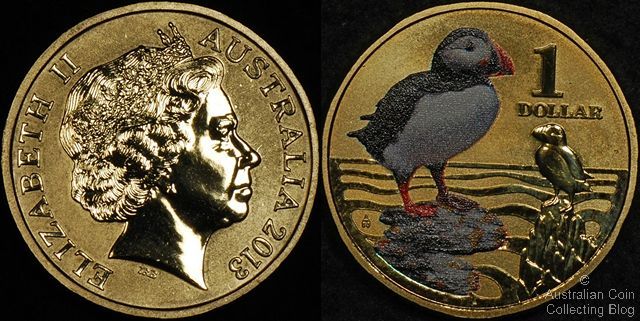
Australia 2013 Atlantic Puffin Coloured 1 Dollar
The Altantic Puffin is one of the last coloured dollar coins in the Royal Australian Mint's Polar Animals series. The series focuses on animals that live in some of the coldest areas in the world. This reverse, a coloured bird, the Atlantic Puffin.
Did you know that the Atlantic Puffin is the official bird emblem of Newfoundland and Labrador in Canada?
And that the British Island of Lundy (which in Norse means "puffin island") may have been used by the Vikings to rest and restock their food supplies, before and after their mainland raids.
The self-declared 'King of Lundy' who was really just an English businessman Martin Coles Harman purchased Lundy in 1925 and struck unofficial currency for the island in 1929, the denomominations the half puffin and puffin! These fantasies were restruck in 1965 and 2011. The puffin has also appeared on Canadian currency.
School children from the 1940's probably remember being a member of the Puffin Book Club and owning a much loved children's Puffin paperback.
The Atlantic Puffin's most prominent feature is their triangulated beak, which becomes exceptionally colourful in the breeding season, giving them the nickname "parrots of the sea".
They've also been called the "clown of the sea", having some rather unusual mannerisms. Dominance is shown to one another by standing as upright as they can, fluffing out their chest feathers and cocking their tails, then walking very slowly past one another in a very exaggerated manner, all the while jerking their heads and gaping their beaks. Those that show subservience will lower their heads, position their body in a low horizontal manner and scurry past the dominant Puffin as quickly as they can.
And then there's "billing" (or "kissing"), the ritual performed by reuniting Puffins prior to and right through the mating season. As they approach one another, they wag their heads from side to side and rattle their beaks together.
Puffins were thought to be monogamous, but scientists now believe that their "true love" is their nesting sites, returning to the same burrow each year. They're very solitary animals and spend most of the winter out at sea. Because of this it's unclear if mating couples meet first out at sea or when returning to the burrow. Either way, coming back to the same burrow each year is probably just the most efficient way to ensure they connect with the right mate.
Female Puffins will only lay 1 egg during the mating season, but if "lost" early in the season, another egg may be laid. Baby chicks are called "pufflings."
Seals, large fish, the Great Black-backed Gull and the Great Skua are the Puffins natural predators. When bobbing around on the ocean, Puffins are often seen putting their head underwater scouting for predators. Aerial acrobatics and wheeling around cliff faces come in very handy to outmanoeuver flying predators.
Man however, has yet again, played a part in being a significant threat to Puffins - from hunting for meat, to removal of eggs, through to feathers being used for bedding & insulation. Feral animals have also been introduced into the Puffin's territory - such as on the Island of Lundy with the numbers decreasing in 2000 to just 10 pairs of breeding birds due to a rat plague, the rats being responsible for eating eggs and young chicks.
Oil spills also reduce Puffin numbers. When a bird's feathers become "oiled" they are less able to insulate themselves, becoming vulnerable to temperature changes and reduced buoyancy at sea.
Global warming however, may be benefiting the Atlantic Puffin. As sea surface temperature rises, so does plankton abundance, which in turn stimulates the small fish populations that Puffins eat.
The Atlantic Puffin coin is released as a standard 9 gram 25 millimetre dollar coin. The reverse frosted uncirculated finish is a design by Aaron Baggio, with the obverse portrait of Queen Elizabeth II by Ian Rank-Broadley. This coin is one of six coins in this series -previously released coins depict the Polar Bear, Rockhopper Penguin, Weddell Seal, Walrus and the Humpback Whale. The Polar Animals series follows the successful Animals of the Zoo Series of 2012 and the Air, Land and Ocean series of previous years.
As with previously issued coins, the Atlantic Puffin coin retails at $15 and is presented in a colourful collector's card. Mintage is unlimited at this time and will be determined by collector demand. This coin is listed in our 2013 1 dollar coin mintages table, see the variety of Australian dollar coins issued in 2013.
Posted by harrisk at September 4, 2013 12:31 PM
Subscribe to our Newsletter


